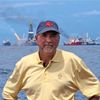
Exactly one week ago, Shell triumphantly announced the resumption of drilling in the offshore Arctic after a 20-year hiatus. The drillship Noble Discoverer spud (began drilling) the first new Burger prospect well in the Chukchi Sea; less than 24 hours later, they had to shut down and move 30 miles away to allow for a huge ice floe to move through the area. They've been there ever since, monitoring ice. The giant ice floe they are watching is approximately 30 miles long, 12 miles wide, and up to 82 feet thick in some spots. The floe is moving at .2 knots (barely a crawl), and continues to block the Burger drill site.
At the same time in the Beaufort Sea, the drilling barge Kulluk remains on standby waiting for the fall whaling season by the Inupiat people who live in the far north of Alaska. Shell agreed to suspend offshore operations during the native whaling season, which goes through early October. Winter will set in soon after that, bringing ice again to the region.
Since the Kulluk is a reinforced barge, it can withstand heavy sea ice due to its hull design that is described as a Earl & Wright/Sedco Arctic drilling vessel with an inverted, truncated, conically shaped ice-strengthened hull (That's a mouthful). Essentially, this uniquely designed rig is actually a huge bowl that rides up on top of encroaching sea ice rather than being crushed by it. The deck is almost round, measuring about 270 feet across, weighs in at almost 28,000 gross tons, and has a derrick capacity of 1.2 million pounds. It is moored to the seafloor by 12 anchors and utilizes a 10,000 psi rated subsea blowout preventer (BOP). The rig was built by Mitsui in 1983, and has spent its entire life in Canadian and Alaskan waters, and will spend the foreseeable future drilling in the Beaufort Sea.
With their decades of planning, detailed contingency plans, and public communication program, I believe that Shell is diligently working to manage risks to the environment, the needs of the local people, and that they have a strong commitment to safety. However, because they are diligent doesn't explain why they are having to manage those risks trying to get to huge hydrocarbon resources that are below some of the most extreme conditions in the world. The fact that they are there, similar to drilling in the deepwater, raises two fundamental questions: First, what about the safety of ongoing operations in the offshore Arctic, and second, why do we have an energy policy (or, rather, lack thereof) that drives oil companies like Shell into operations that carry this much inherent risk?
I had hoped that the disaster in the Gulf of Mexico over two years would have led to at least discussions of a rational, reasoned energy policy that would drive us towards sustainable energy development. Unfortunately, our politicians did what politicians always do when the People don't push them to doing the right thing: nothing. In fact, we've actually gone backwards in some cases, with the House of Representatives actually legislating less oversight and less permit review. Yes, some drilling safety regulations have been improved, and containment capability has been constructed. However, we haven't fixed some of the gaping holes in our offshore drilling policy. For example, the $75 million statutory cap on liability for environmental damage remains unchanged at the same level it was when passed by Congress 22 years ago as part of the Oil Pollution Act. In a weird way, we were fortunate that BP was the operator of the infamous Macondo well.
Why? Here's why. There are less than 20 companies actively operating in the deepwater in the Gulf of Mexico. Had this disaster happened to one of those operators besides BP, Shell, Exxon, Chevron, or BHP, one of two things would have likely happened; the company would have gone bankrupt, or paid its $75 million statutory cap and gone home. In both cases, the rest of the cleanup would fall directly on you, the taxpayer. Before the 2010 election, the House, under Democratic control, attempted to raise the liability cap. When the Republicans took over in January of 2011, that effort died a swift death. No legislative action to improve drilling safety or enact comprehensive policy has been taken. None.
We are on an unsustainable path in energy consumption, and a comprehensive policy that drives the U.S. to responsible development and use is one of the most critical issues facing us today. The tragedy is that rather than working on that, our political leaders are arguing about abortion, birth control (believe it or not), gay marriage, "welfare queens," busting unions, undoing remaining gun legislation, keeping people from voting, handing healthcare decisions back to insurance companies, privatizing Medicare and Medicaid, deregulating the banking system, cutting taxes, building an even bigger military, and starting another war by invading Iran. Electioneering is Job One for our leaders, being paid for by the few. We're not even talking about talking about a policy, much less actually doing anything.
I continue to fear that it will take another disaster, maybe larger than the Macondo well blowout, to get the attention of the People. Once the People wake up, perhaps we can wake up our politicians.
